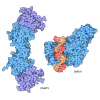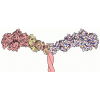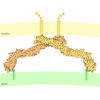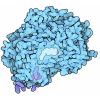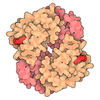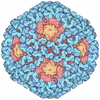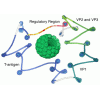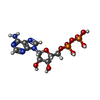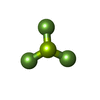+ Open data
Open data
- Basic information
Basic information
| Entry |  | |||||||||
|---|---|---|---|---|---|---|---|---|---|---|
| Title | The nucleosome-bound human PBAF complex | |||||||||
 Map data Map data | PBAF overall map | |||||||||
 Sample Sample |
| |||||||||
 Keywords Keywords | chromatin remodeling complexes / DNA BINDING PROTEIN / DNA BINDING PROTEIN-DNA complex | |||||||||
| Function / homology |  Function and homology information Function and homology informationsingle stranded viral RNA replication via double stranded DNA intermediate / positive regulation of glucose mediated signaling pathway / regulation of DNA strand elongation / positive regulation of telomere maintenance in response to DNA damage / positive regulation of transcription of nucleolar large rRNA by RNA polymerase I / bBAF complex / npBAF complex / nBAF complex / brahma complex / neural retina development ...single stranded viral RNA replication via double stranded DNA intermediate / positive regulation of glucose mediated signaling pathway / regulation of DNA strand elongation / positive regulation of telomere maintenance in response to DNA damage / positive regulation of transcription of nucleolar large rRNA by RNA polymerase I / bBAF complex / npBAF complex / nBAF complex / brahma complex / neural retina development / negative regulation of androgen receptor signaling pathway / N-acetyltransferase activity / histone H3K14ac reader activity / GBAF complex / blastocyst hatching / EGR2 and SOX10-mediated initiation of Schwann cell myelination / nucleosome array spacer activity / regulation of G0 to G1 transition / hepatocyte differentiation / Tat protein binding / coronary artery morphogenesis / XY body / RSC-type complex / Ino80 complex / blastocyst formation / regulation of nucleotide-excision repair / RNA polymerase I preinitiation complex assembly / regulation of double-strand break repair / ATP-dependent chromatin remodeler activity / cellular response to fatty acid / host-mediated activation of viral transcription / nucleosome disassembly / germ cell nucleus / SWI/SNF complex / regulation of mitotic metaphase/anaphase transition / positive regulation of T cell differentiation / nuclear androgen receptor binding / positive regulation of double-strand break repair / nuclear chromosome / negative regulation of G1/S transition of mitotic cell cycle / homeostatic process / spinal cord development / NuA4 histone acetyltransferase complex / regulation of chromosome organization / positive regulation of stem cell population maintenance / RUNX1 interacts with co-factors whose precise effect on RUNX1 targets is not known / Regulation of MITF-M-dependent genes involved in pigmentation / regulation of G1/S transition of mitotic cell cycle / regulation of DNA replication / regulation of embryonic development / negative regulation of cell differentiation / positive regulation of signal transduction by p53 class mediator / positive regulation of Wnt signaling pathway / cardiac muscle cell proliferation / positive regulation of myoblast differentiation / embryonic organ development / ATP-dependent activity, acting on DNA / heart morphogenesis / positive regulation of double-strand break repair via homologous recombination / histone acetyltransferase activity / regulation of DNA repair / Chromatin modifying enzymes / Packaging Of Telomere Ends / Regulation of TP53 Activity through Acetylation / : / DNA polymerase binding / neurogenesis / Recognition and association of DNA glycosylase with site containing an affected purine / Cleavage of the damaged purine / Deposition of new CENPA-containing nucleosomes at the centromere / Recognition and association of DNA glycosylase with site containing an affected pyrimidine / Cleavage of the damaged pyrimidine / telomere maintenance / Interleukin-7 signaling / Inhibition of DNA recombination at telomere / RNA Polymerase I Promoter Opening / Meiotic synapsis / transcription initiation-coupled chromatin remodeling / Assembly of the ORC complex at the origin of replication / regulation of mitotic cell cycle / positive regulation of DNA repair / Regulation of endogenous retroelements by the Human Silencing Hub (HUSH) complex / negative regulation of cell migration / DNA methylation / Condensation of Prophase Chromosomes / Chromatin modifications during the maternal to zygotic transition (MZT) / SIRT1 negatively regulates rRNA expression / HCMV Late Events / ERCC6 (CSB) and EHMT2 (G9a) positively regulate rRNA expression / nuclear receptor binding / transcription coregulator binding / PRC2 methylates histones and DNA / Regulation of endogenous retroelements by KRAB-ZFP proteins / Defective pyroptosis / DNA Damage Recognition in GG-NER / Regulation of endogenous retroelements by Piwi-interacting RNAs (piRNAs) / transcription coregulator activity / positive regulation of cell differentiation / HDACs deacetylate histones / transcription elongation by RNA polymerase II Similarity search - Function | |||||||||
| Biological species |  Homo sapiens (human) Homo sapiens (human) | |||||||||
| Method | single particle reconstruction / cryo EM / Resolution: 4.4 Å | |||||||||
 Authors Authors | Wang L / Yu J / Yu Z / Wang Q / He S / Xu Y | |||||||||
| Funding support |  China, 2 items China, 2 items
| |||||||||
 Citation Citation |  Journal: Nat Commun / Year: 2022 Journal: Nat Commun / Year: 2022Title: Structure of nucleosome-bound human PBAF complex. Authors: Li Wang / Jiali Yu / Zishuo Yu / Qianmin Wang / Wanjun Li / Yulei Ren / Zhenguo Chen / Shuang He / Yanhui Xu /  Abstract: BAF and PBAF are mammalian SWI/SNF family chromatin remodeling complexes that possess multiple histone/DNA-binding subunits and create nucleosome-depleted/free regions for transcription activation. ...BAF and PBAF are mammalian SWI/SNF family chromatin remodeling complexes that possess multiple histone/DNA-binding subunits and create nucleosome-depleted/free regions for transcription activation. Despite previous structural studies and recent advance of SWI/SNF family complexes, it remains incompletely understood how PBAF-nucleosome complex is organized. Here we determined structure of 13-subunit human PBAF in complex with acetylated nucleosome in ADP-BeF-bound state. Four PBAF-specific subunits work together with nine BAF/PBAF-shared subunits to generate PBAF-specific modular organization, distinct from that of BAF at various regions. PBAF-nucleosome structure reveals six histone-binding domains and four DNA-binding domains/modules, the majority of which directly bind histone/DNA. This multivalent nucleosome-binding pattern, not observed in previous studies, suggests that PBAF may integrate comprehensive chromatin information to target genomic loci for function. Our study reveals molecular organization of subunits and histone/DNA-binding domains/modules in PBAF-nucleosome complex and provides structural insights into PBAF-mediated nucleosome association complimentary to the recently reported PBAF-nucleosome structure. | |||||||||
| History |
|
- Structure visualization
Structure visualization
- Downloads & links
Downloads & links
-EMDB archive
| Map data |  emd_33684.map.gz emd_33684.map.gz | 168 MB |  EMDB map data format EMDB map data format | |
|---|---|---|---|---|
| Header (meta data) |  emd-33684-v30.xml emd-33684-v30.xml emd-33684.xml emd-33684.xml | 53.1 KB 53.1 KB | Display Display |  EMDB header EMDB header |
| Images |  emd_33684.png emd_33684.png | 89.1 KB | ||
| Filedesc metadata |  emd-33684.cif.gz emd-33684.cif.gz | 13.6 KB | ||
| Others |  emd_33684_additional_1.map.gz emd_33684_additional_1.map.gz emd_33684_additional_2.map.gz emd_33684_additional_2.map.gz emd_33684_additional_3.map.gz emd_33684_additional_3.map.gz emd_33684_half_map_1.map.gz emd_33684_half_map_1.map.gz emd_33684_half_map_2.map.gz emd_33684_half_map_2.map.gz | 168.2 MB 168.1 MB 167.6 MB 164.9 MB 164.9 MB | ||
| Archive directory |  http://ftp.pdbj.org/pub/emdb/structures/EMD-33684 http://ftp.pdbj.org/pub/emdb/structures/EMD-33684 ftp://ftp.pdbj.org/pub/emdb/structures/EMD-33684 ftp://ftp.pdbj.org/pub/emdb/structures/EMD-33684 | HTTPS FTP |
-Validation report
| Summary document |  emd_33684_validation.pdf.gz emd_33684_validation.pdf.gz | 1.2 MB | Display |  EMDB validaton report EMDB validaton report |
|---|---|---|---|---|
| Full document |  emd_33684_full_validation.pdf.gz emd_33684_full_validation.pdf.gz | 1.2 MB | Display | |
| Data in XML |  emd_33684_validation.xml.gz emd_33684_validation.xml.gz | 14.9 KB | Display | |
| Data in CIF |  emd_33684_validation.cif.gz emd_33684_validation.cif.gz | 17.7 KB | Display | |
| Arichive directory |  https://ftp.pdbj.org/pub/emdb/validation_reports/EMD-33684 https://ftp.pdbj.org/pub/emdb/validation_reports/EMD-33684 ftp://ftp.pdbj.org/pub/emdb/validation_reports/EMD-33684 ftp://ftp.pdbj.org/pub/emdb/validation_reports/EMD-33684 | HTTPS FTP |
-Related structure data
| Related structure data |  7y8rMC M: atomic model generated by this map C: citing same article ( |
|---|---|
| Similar structure data | Similarity search - Function & homology  F&H Search F&H Search |
- Links
Links
| EMDB pages |  EMDB (EBI/PDBe) / EMDB (EBI/PDBe) /  EMDataResource EMDataResource |
|---|---|
| Related items in Molecule of the Month |
- Map
Map
| File |  Download / File: emd_33684.map.gz / Format: CCP4 / Size: 178 MB / Type: IMAGE STORED AS FLOATING POINT NUMBER (4 BYTES) Download / File: emd_33684.map.gz / Format: CCP4 / Size: 178 MB / Type: IMAGE STORED AS FLOATING POINT NUMBER (4 BYTES) | ||||||||||||||||||||
|---|---|---|---|---|---|---|---|---|---|---|---|---|---|---|---|---|---|---|---|---|---|
| Annotation | PBAF overall map | ||||||||||||||||||||
| Voxel size | X=Y=Z: 1.334 Å | ||||||||||||||||||||
| Density |
| ||||||||||||||||||||
| Symmetry | Space group: 1 | ||||||||||||||||||||
| Details | EMDB XML:
|
-Supplemental data
- Sample components
Sample components
+Entire : Nucleosome-bound human PBAF complex
+Supramolecule #1: Nucleosome-bound human PBAF complex
+Macromolecule #1: Histone H3
+Macromolecule #2: Histone H4
+Macromolecule #3: Histone H2A type 1-C
+Macromolecule #4: Histone H2B
+Macromolecule #5: Unknown
+Macromolecule #6: Transcription activator BRG1
+Macromolecule #7: ACTB protein (Fragment)
+Macromolecule #8: Actin-like protein 6A
+Macromolecule #9: AT-rich interactive domain-containing protein 2
+Macromolecule #10: SWI/SNF-related matrix-associated actin-dependent regulator of ch...
+Macromolecule #11: SWI/SNF complex subunit SMARCC2
+Macromolecule #12: Unknown
+Macromolecule #13: SWI/SNF-related matrix-associated actin-dependent regulator of ch...
+Macromolecule #14: SWI/SNF-related matrix-associated actin-dependent regulator of ch...
+Macromolecule #15: PHD finger protein 10
+Macromolecule #16: Bromodomain-containing protein 7
+Macromolecule #17: Unkown
+Macromolecule #18: Protein polybromo-1
+Macromolecule #19: Unknown
+Macromolecule #22: Unknown
+Macromolecule #20: DNA (213-MER)
+Macromolecule #21: DNA (213-MER)
+Macromolecule #23: ADENOSINE-5'-DIPHOSPHATE
+Macromolecule #24: MAGNESIUM ION
+Macromolecule #25: BERYLLIUM TRIFLUORIDE ION
-Experimental details
-Structure determination
| Method | cryo EM |
|---|---|
 Processing Processing | single particle reconstruction |
| Aggregation state | particle |
- Sample preparation
Sample preparation
| Buffer | pH: 8 |
|---|---|
| Vitrification | Cryogen name: ETHANE |
- Electron microscopy
Electron microscopy
| Microscope | FEI TITAN KRIOS |
|---|---|
| Image recording | Film or detector model: GATAN K3 (6k x 4k) / Average electron dose: 50.0 e/Å2 |
| Electron beam | Acceleration voltage: 300 kV / Electron source:  FIELD EMISSION GUN FIELD EMISSION GUN |
| Electron optics | Illumination mode: OTHER / Imaging mode: BRIGHT FIELD / Nominal defocus max: 2.5 µm / Nominal defocus min: 1.0 µm |
| Experimental equipment |  Model: Titan Krios / Image courtesy: FEI Company |
- Image processing
Image processing
| Startup model | Type of model: NONE |
|---|---|
| Final reconstruction | Resolution.type: BY AUTHOR / Resolution: 4.4 Å / Resolution method: FSC 0.143 CUT-OFF / Number images used: 37528 |
| Initial angle assignment | Type: MAXIMUM LIKELIHOOD |
| Final angle assignment | Type: MAXIMUM LIKELIHOOD |
 Movie
Movie Controller
Controller




